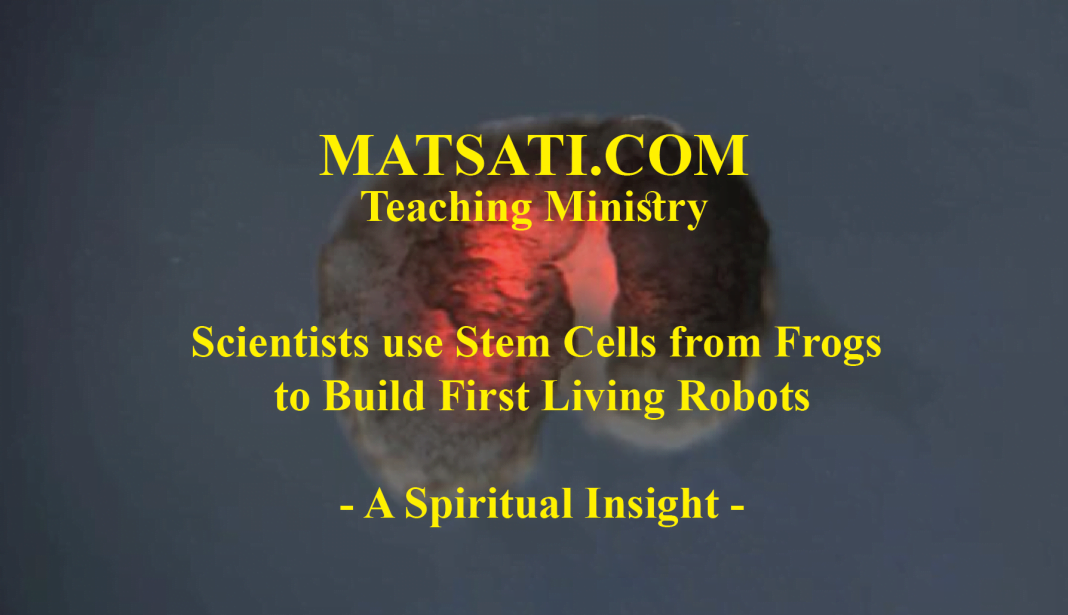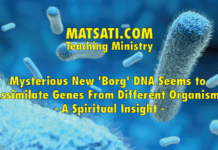Researchers in the United States have created the first fully organic living robots by assembling cells from African clawed frogs into small robots that move around under their own power. The research paper [1] reports the creation of one robot that propels itself along using two legs, and another robot with a hole in the middle that can be used to carry objects. These are custom made lifeforms that have never existed before on Earth, and they are what the researchers from the Allen Discovery Center at Tufts University in Medford Massachusetts call “programmable organisms.” Today, we understand robotics as a careful combination of metal and plastic for both strength and durability. These researchers believe there are additional benefits for making robots from biological tissues. The idea is when these robots become damaged, they are capable of healing themselves, and once their programmed task is completed, they die, decay, and decompose.
References
- Kriegman, S.; Blackiston, D.; Levin, M.; Bongard, J., A scalable pipeline for designing reconfigurable organisms, Proceedings of the National Academy of Sciences 2020, 201910837, https://doi.org/10.1073/pnas.1910837117
- D. J. Blackiston, M. Levin, Ectopic eyes outside the head in Xenopus tadpoles provide sensory data for light-mediated learning. J. Exp. Biol. 216, 1031–1040 (2013). https://doi.org/10.1242/jeb.074963
- L. N. Vandenberg, D. S. Adams, M. Levin, Normalized shape and location of perturbed craniofacial structures in the Xenopus tadpole reveal an innate ability to achieve correct morphology. Dev. Dyn. 241, 863–878 (2012). https://doi.org/10.1002/dvdy.23770
- R. D. Kamm et al., Perspective: The promise of multi-cellular engineered living systems. APL Bioeng 2, 040901 (2018). https://doi.org/10.1063/1.5038337
One of the goals of this research is for the rapid design and implementation of these living systems for specific jobs. The researchers point out the potential of the use of living embryonic cells has the ability to resist entropy stating the following:
“As examples of this resistance, embryonic development and regeneration reveal remarkable plasticity, enabling cells or whole organ systems to self-organize adaptive functionality despite drastic deformation. [1-2] Exploiting the computational capacity of cells to function in novel configurations suggests the possibility of creating synthetic morphology that achieves complex novel anatomies via the benefits of both emergence and guided self-assembly.” [3]
Future applications for this type of technology would be to clean up microplastics pollution, locate and digest toxic materials, drug delivery, or to remove plaque from artery walls, etc. This technology was made possible by artificial intelligence (AI) methods. The researchers began with models using silicon, then transferred the design to living systems using a cell-based construction toolkit in order to create a living system with programmable behavior. This was accomplished using AI and robotic automation. Some steps however do require manual human intervention. The Organic robots that were created were 1 mm long, and the AI program begins by generating random 3-dimensional configurations of 500-1000 skin and heart cells. The heart cells are used as the mechanism for motion. Each design is tested in a virtual environment to see how far the robot can move when the heart cells are initiated to beating motion. Heart cells naturally expand and contract and therefore are the miniature engine that drives robotic movement until the energy reserves run out. The researchers reported these robots have enough fuel inside for them to be functional for a week to ten days before dying. The AI system generated 100 generations of a handful of designs before the researchers began the manufacturing process in the lab. The scientists used tweezers and cauterizing tools to scrap skin and heart cells from embryos of African clawed frogs (Xenopus laevis). The source of the materials for the robots (the cells) led to the name “xenobots.” The researchers used frog cells (amphibian cells) with the future prospect of using mammalian cells which may allow them to live on dry land. The future plans for this technology is to develop blood vessels, nervous systems, and sensory cells to form rudimentary eyes, etc. An ethical dilemma may occur as these robotic systems may be used for more cognitive capabilities so they are more versatile in their applications, that is a long way off. The ultimate goal is to learn more about living systems, the mechanisms for making organic robotics, and being able to program and manipulate these materials. The things we may learn from this kind of materials development research is to have a greater understanding on topics such as birth defects, cancer, age-related diseases, etc, all of which may be corrected or solved once we have a greater understanding of these biological functions and structures which would lead ultimately to having greater control over growth and form.
The Spiritual insights that we receive from this type of research on synthetic lifeforms and robotics draws us back to the creation account, the Lord God as our creator and sustainer of all things. When we read through the creation account, in Bereshit / Genesis 2:4, we are told the Lord God Almighty created the “generations” of the heavens and the earth, using the Hebrew word toldot (תולדות). It is interesting to study the word Toldot in the Torah, because this represents the created order of all things before man falling into sin. Following the fall into sin, this word toldot is spelled slightly differently, as תלדות. (each time in Bereshit / Genesis 36) Notice how this is a defective spelling for the phrase “Generations” and each time the phrase appears in the phrase “these are the generations of” as the Torah describes the generations of the heads of families, this word is spelled defectively with a missing vav (ו). The vav appears to be lost. Using the Judaic Classics software, searching for תולדות shows two search results, the first in our verse (Bereshit / Genesis 2:4) and the second in the book of Ruth 4:18. Here we find in Ruth 4 this formulaic way of saying the generations of Perez, and the word toldot is spelled with the vav restored. The way the text is written showing the missing vav, this leads us to consider the connection between the creation of heaven and earth and the fall of Mankind, and then the creation of the family line of Perez. As we know, the number six, the letter vav (ו) represents man, and the very first vav in the Torah is associated with the first man, Adam. The name Perez means “breach” meaning to break through something. This imagery given here suggests the Lord God Almighty is breaking through and restoring something indicated by the restoration of the letter vav (ו). In the story of Ruth we read about God’s redemption, the kinsman redeemer, and through the family line of Ruth of the Messiah Yeshua. This vav may provide us with a picture of the Messiah, who is the descendent from the generations of Perez, who then goes on to live a perfect life according to the Torah, laying his life down on our behalf in payment for sin, and abolishing death and separation. The first vav (ו) was lost through the sin and disobedience of Adam, the vav (ו) was restored in the second Adam, the Messiah Yeshua.
As man continues to learn more about God’s creation, he gains the ability to use or manipulate the materials we find here on earth, even those materials form living systems to make new living systems. This also reminds us of what is written in the Scriptures following the great flood according to Bereshit / Genesis 11:1-6.
Bereshit / Genesis 11:1-6
11:1 Now the whole earth used the same language and the same words. 11:2 It came about as they journeyed east, that they found a plain in the land of Shinar and settled there. 11:3 They said to one another, ‘Come, let us make bricks and burn them thoroughly.’ And they used brick for stone, and they used tar for mortar. 11:4 They said, ‘Come, let us build for ourselves a city, and a tower whose top will reach into heaven, and let us make for ourselves a name, otherwise we will be scattered abroad over the face of the whole earth.’ 11:5 The Lord came down to see the city and the tower which the sons of men had built. 11:6 The Lord said, ‘Behold, they are one people, and they all have the same language. And this is what they began to do, and now nothing which they purpose to do will be impossible for them. (NASB)
This is a confirmation of what we read in Bereshit / Genesis 1 of God having created man after His image, we are given the ability to think creatively. Note how all of the earth had the same language. When the language barrier was broken down and English became the predominant language (or as kingdoms were established and more people learned one language), notice how technology advanced. This is a unique property over all of God’s creation. Here men used their creative ability to come together and build a city to make their name great, even to surpass God in heaven. So the Lord came down to see what man was accomplishing, and stated, 11:6 The Lord said, ‘Behold, they are one people, and they all have the same language. And this is what they began to do, and now nothing which they purpose to do will be impossible for them. (NASB) A similar thing we see going on here in the scientific research, man using his creative process to learn, understand, and then build something new and that has never been seen before. All we have to do is look around us and see all of the technological advances to know these things to be true. Everything begins with the foundation of truth, that our God is a personal creator. Truth is the principle for all rational thinking. This is drawn out in the scientific principle. For example, what happens in the applied sciences, one is presented with a problem statement. The Scientist takes the basic knowledge of mathematics (engineering), chemistry, and physics and generates a hypothesis on how to solve the problem. In addition to this, a literature review is conducted to see how others have approached this problem and their solution, and to see if anyone else has attempted to solve the problem statement. Once this is completed, the Scientist proposes a set of experiments to test his or her hypothesis. The experiments are run, and the results are analyzed based upon the assumptions that are made in the hypothesis. If the data does not agree with the hypothesis, then more tests are conducted, or the hypothesis is modified, or an entirely new approach needs to be examined. This iteration step is continued until success or failure. What this demonstrates for us is how what one has been taught (mathematics, engineering, chemistry, and physics) affects the way one interprets and conducts research! Note how in the scientific research on “Stem Cells from Frogs to Build First Living Robots” the scientists are simply taking what exists (stem cells from frogs) and then applying them in a new way to build a robot. In this case man is not creating something from nothing, but taking what he knows, what he has, and applying it in a new and creative way. The Torah relates that God created the heavens and the earth from nothing, He spoke all of creation into existence. “The earth was without form and void (תהוּ וָבהוּ) and darkness was over the face of the deep, and the Spirit of God (רוּחַ אֱלהִים) was hovering over the face of the waters, and God said, ‘Let there be light’” (Bereshit / Genesis 1:2-3). Notice how God has revealed Himself to us here in the second verse of the Torah, the Divine Word of God and the Spirit of God cannot be separated from God Himself. The implication here that God is our Creator is enormous and penetrates everything that we do. Just as in the Scientific research on stem cells from frogs, this research would not be possible without the materials that were created by God! Even in this creative process, where man develops a robot from skin and heart cells, God’s creative power is witnessed by all. Since we were created in the image of God, the witness of God’s truth through our creativity is a foundation to all of our thinking and reasoning. This scientific research is phenomenal, considering what man is able to do, and the revelation of these things (not the invention itself) of logical principles that were used in part to develop this technology, is part of God’s signature on our lives, whether one knows the God of Israel or not! Our ability to think… to reason… and to use logic in conjunction with physics and chemistry (i.e. science)… our ability for awareness… of having a mind that is aware to reality… to know things and to use knowledge to help others… this is God’s signature on all of mankind. Because of these things we have been given the ability to be aware of the existence of moral truth, that there is a standard for justice and moral law. Or even that there is a truth to beauty, ideals, goodness, worth, and love. We have the capability for reasoning in metaphysical truths such as cause and effect. We are told according to David in Tehillim / Psalms 19:1 “The heavens are recounting the glory of God, and the expanse is proclaiming his handiwork.” Just by examining these things, such as the scientific research, God’s power and presence can be clearly inferred by the necessity of the materials being available for its specific application. This is why Paul wrote what he did saying, God’s power and presence can be clearly inferred from the tremendous effect of the universe itself. As Paul stated, “the invisible things of Him (τά ἀόρατα αὐτοῦ) from the creation of the world are clearly seen (καθοράω), so that people are without excuse.” (Romans 1:19-20) When we consider the awesome power of God, we truly realize that it is the fear of the LORD (יִרְאַת יהוה) that is the beginning of wisdom and knowledge (see Tehillim / Psalm 111:10 and Mishley / Prov. 1:7, 9:10). Notice how the Hebrew word for fearing (ירא) and seeing (ראה) share the same root. The ultimate conclusion is we cannot truly see reality, even the scientific research, apart from reverencing God as the Lord and King of Creation! Remember, the first word in the Bible, בְּרֵאשִׁית Bereshit, means “beginning” and is based on the term rosh (ראשׁ, “head”). The first word in the Bible directs us to “the head of (all things),” namely God (אֱלֹהִים). The Lord God of Israel must be the starting point of all our thinking about life; God is the Axiom of Reality; He is the First Principle of all Being.









